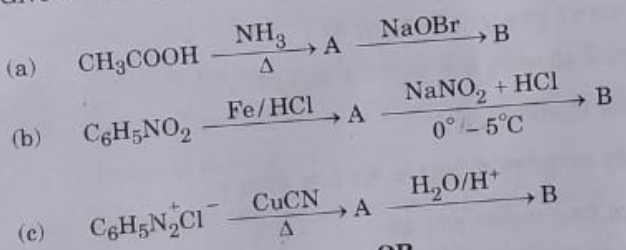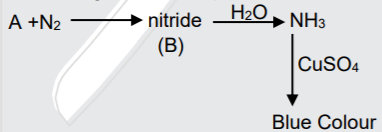KHORANA synthesized two RNAs (a) with repeat sequence of AB and (b) with repeat sequence of ABC the polypeptides code by (a) & (b) are respectively :-
Homopolypeptides in both (a) and (b)
Heteropolypeptides in both
Homopolypeptide in (a) & peptide heteropoly in (b)
Heteropolypeptide in (a) & peptide homopoly in (b)
The correct Answer is:D
To solve the question regarding the polypeptides coded by the two RNA sequences synthesized by Khorana, we will analyze each RNA sequence and determine the type of polypeptide they produce.
1. Identify the RNA Sequences:
- RNA (a) has a repeat sequence of AB.
- RNA (b) has a repeat sequence of ABC.
2. Determine Codons for RNA (a):
- The repeat sequence of AB can be represented as: ABABAB...
- To form codons, we group the sequence into sets of three nucleotides.
- Possible codons from ABABAB... are:
- 1st codon: ABA
- 2nd codon: BAB
- 3rd codon: ABA
- This pattern continues, alternating between ABA and BAB.
- Since there are two different codons (ABA and BAB), this RNA will code for a heteropolypeptide.
3. Determine Codons for RNA (b):
- The repeat sequence of ABC can be represented as: ABCABCABC...
- Grouping this into sets of three nucleotides gives us:
- 1st codon: ABC
- 2nd codon: ABC
- 3rd codon: ABC
- This pattern continues with only ABC repeating.
- Since all codons are the same (ABC), this RNA will code for a homopolypeptide.
4. Conclusion:
- RNA (a) produces a heteropolypeptide (due to the presence of different codons ABA and BAB).
- RNA (b) produces a homopolypeptide (due to the repeated codon ABC).
- Therefore, the correct answer is: heteropolypeptide in A and homopolypeptide in B.
Final Answer:
The polypeptides coded by the RNAs are:
- RNA (a) - Heteropolypeptide
- RNA (b) - Homopolypeptide
- RNA (a) has a repeat sequence of AB.
- RNA (b) has a repeat sequence of ABC.
- The repeat sequence of AB can be represented as: ABABAB...
- To form codons, we group the sequence into sets of three nucleotides.
- Possible codons from ABABAB... are:
- 1st codon: ABA
- 2nd codon: BAB
- 3rd codon: ABA
- This pattern continues, alternating between ABA and BAB.
- Since there are two different codons (ABA and BAB), this RNA will code for a heteropolypeptide.
- The repeat sequence of ABC can be represented as: ABCABCABC...
- Grouping this into sets of three nucleotides gives us:
- 1st codon: ABC
- 2nd codon: ABC
- 3rd codon: ABC
- This pattern continues with only ABC repeating.
- Since all codons are the same (ABC), this RNA will code for a homopolypeptide.
- RNA (a) produces a heteropolypeptide (due to the presence of different codons ABA and BAB).
- RNA (b) produces a homopolypeptide (due to the repeated codon ABC).
- Therefore, the correct answer is: heteropolypeptide in A and homopolypeptide in B.
The polypeptides coded by the RNAs are:
- RNA (a) - Heteropolypeptide
- RNA (b) - Homopolypeptide
Topper's Solved these Questions
- GENETICS & MOLECULAR BASIS OF INHERITANCE AND MUTATIONBOOK - ALLENCHAPTER - GENETICS & MOLECULAR BASIS OF INHERITANCE AND MUTATIONEXERCISE - EXERCISE-IV (ASSERTION & REASON)
144 Videos
- GENETICS & MOLECULAR BASIS OF INHERITANCE AND MUTATIONBOOK - ALLENCHAPTER - GENETICS & MOLECULAR BASIS OF INHERITANCE AND MUTATIONEXERCISE - EXERCISE-II (PREVIOUS YEAR QUESTIONS
104 Videos
- GENETICS BOOK - ALLENCHAPTER - GENETICS EXERCISE - Question
58 Videos
- GENETICS (PRINCIPLES OF INHERITANCE AND VARIATION) (MOLECULAR BASIS OF INHERITANCE)BOOK - ALLENCHAPTER - GENETICS (PRINCIPLES OF INHERITANCE AND VARIATION) (MOLECULAR BASIS OF INHERITANCE)EXERCISE - Question
53 Videos
Similar Questions
Knowledge Check

In the above reaction sequence, A , B and C respectively areAbenzene, nitrobenzene, anilineBbenzene ,m-dinitrobenzene , m-nitroanilineCtouluene, m-nitrotoluene, m-toluidineDbenzene, nitrobenzene, hydrazobenzene.
In the given reaction sequence B is

View SolutionIn the given reaction sequence B is

View SolutionGive the structures of A and B in the following sequence of reactions

View SolutionThe reagents A and B in the reaction sequence
_E01_693_Q01.png)
are given by the set:-
View SolutionConsider the following sequence of reactions.

The product [A] and [B] are respectively
View SolutionIn the reaction sequences

A,B,C and D are given by the set:
View SolutionIn the sequence of reactions , . The product B is

View Solution


